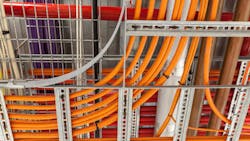The Future of Building Integration Could Be Your Old Wiring
Imagine transforming your building into a smart, interconnected space without having to tear down walls or lay new cable. It sounds almost too good to be true, right? But with T1L Long-Distance Ethernet, it’s possible for building decision-makers worldwide. This networking technology promises high-speed, secure data transmission over existing wiring that might already be installed in a building without the cost or labor of ripping it out or replacing it.
In an age where data is king, the demand for robust, high-speed networks within buildings has never been higher. Whether it’s for optimizing energy consumption, enhancing occupant comfort, or achieving better energy efficiency, the need for an efficient IP network is clear. However, the cost and disruption of installing new cabling can be prohibitive. That’s where T1L Ethernet steps in, offering a bridge between the old and the new.
T1L, the easier way to say IEEE802.3CG or 10BASE-T1L, is a standard that allows for the transmission of data over a single pair of twisted wires. This means that buildings can leverage their existing infrastructure to support modern IP networks. The benefits are significant: Not only does it reduce installation costs, but it also minimizes the disruption to daily operations during upgrades.
How Does T1L Work?
Unlike traditional Ethernet, which often requires multiple pairs of wires for high-speed communication, T1L uses just one pair. This single-pair Ethernet (SPE) can transmit data at speeds up to 10 Mbps over distances of up to 1 kilometer (IEEE Std 802.3-2022). This capability is particularly advantageous in sprawling facilities where extending network reach without additional cabling is crucial.
The beauty of T1L lies in its compatibility with existing systems. It doesn’t mandate new cabling specifications. Instead, it focuses on the characteristics of the cable used, making it incredibly versatile for, say, retrofit projects.
Why T1L is Ideal for Buildings
The primary allure of T1L for building management is its ability to integrate standard IT protocols into operational technologies without the need for an extensive overhaul. This means buildings can now implement IT-level security, manageability, and data bandwidth with the simplicity of maintaining existing physical infrastructure.
T1L also supports direct IP addressing for sensors and nodes, which can dramatically simplify the connectivity across a building’s network, enhancing both security and efficiency.
Moreover, not only does T1L provide a pragmatic solution for utilizing existing networking cable and LONworks devices for transitioning to more contemporary controller communication, it has been shown to be more efficient in handling data flow over long distances than traditional Cat5/6 cabling, thereby creating significant labor savings for building integrations and even proving a viable option for new construction.
This technology not only supports but also accelerates the transition towards truly smart buildings where every device can communicate and share data seamlessly.
Market Trends and Barriers to Adoption
Market research indicates a growing trend towards IP controller adoption in buildings, especially in regions like Western Europe, where smart building integration is a priority. However, barriers including initial cost, legacy equipment and skills gaps among facility managers have slowed this transition T1L Ethernet addresses these challenges head-on by offering a cost-effective, low-disruption solution.
Beyond Building Management Systems
The potential of T1L extends beyond traditional building management systems. From IP cameras to security systems, fire safety, and even elevator controls, T1L can unify disparate systems under one networking technology, reducing complexity, enhancing interoperability, and enhancing automation.
While not a one-size-fits-all solution, T1L Ethernet represents a significant step forward in building technology. It’s particularly appealing for buildings looking to upgrade their systems without the hefty price tag of a complete network overhaul. As the global IoT market expands, with forecasts predicting nearly 30 billion connected devices by 2027 according to IoT Analytics, technologies like T1L will play a crucial role in managing this growth in an efficient, secure manner.
T1L Long-Distance Ethernet is redefining what’s possible with existing building infrastructure. By marrying the old with the new, it offers a pragmatic path to smarter, more connected buildings. As more organizations recognize its benefits, T1L could well become the backbone of the next generation of building management systems, making our spaces not just smarter, but also more sustainable and adaptable to the future’s demands.
About the Author
Dave Molin
Dave Molin is President of Building Management Systems for Honeywell’s Building Automation segment.
